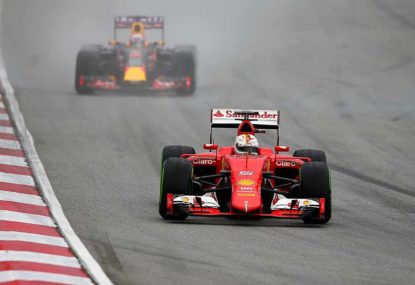It's rewarding mediocrity so every driver wins a prize: Why it should be 'all or nothing' if F1 changes its points system
Given how exclusive and precious a commodity scoring an F1 point is, why is it that mediocrity should be rewarded?

For the first time in two years the Formula One calendar features not just a German Grand Prix but a German Grand Prix at the Hockenheimring.
That no Großer Preis von Deutschland appeared in last season’s schedule after Nurburgring withdrew with finance problems is illustrative of the slow collapse of Formula One in Germany. Even Hockenheim’s race is insecure, with plummeting ticket sales making contract renewal decreasingly attractive.
Not so long ago to think ‘Hockenheim’ was to recall the grandstands encircling the circuit’s famous stadium section heaving, but today only the race’s faded spirit comes to mind.
Despite four of the sport’s drivers, its most dominant team, and half of the championships since 2010 claimable by Germany, the race is held in lukewarm regard. While there are a multitude of factors contributing to the race’s decline, the attitude is a reflection of the circuit itself.
The Hockenheimring used to be fierce – a fast blast through 6.8 kilometres of forest broken up only by three fast chicanes and a handful of other corners.
Today the circuit is a shadow of its former self. It is a 4.5-kilometre reconfiguration of the first and last sectors joined by a long curve.
Though not a bad track, a grand prix at new Hockenheimring doesn’t evoke that history-borne passion the old roads did.
It’s a sad trend becoming increasingly common in Formula One today. Not only are new tracks being designed to such stringent specifications that some are barely discernible from another, old ones are being modified to within an inch of their life to conform to a similar new aesthetic standard, with the difference between old and new Hockenheimring a prime example.
A similar story presented itself in Budapest last week – the Hungaroring ushered in its 31st race with a resurfacing and new kerbs. It wasn’t to the everyone’s taste.
“I don’t have the facts of why they’ve changed it,” said Lewis Hamilton, the circuit’s most successful driver after his win on the weekend. “I wish they didn’t. The track was fricking amazing before.
“The older this track gets, the better it gets, just like a fine wine. I hope they don’t resurface it for a long time, because it’s a track that with age gets better, gains character.”
Daniel Ricciardo, who scored one of his three career wins in Hungary in 2014, was in general agreement.
“It’s like Monaco, for example – out of Casino Square we always avoid the bump,” he said. “If they smooth that out it would lose a lot of Monaco.
“It wasn’t to the extent here with Budapest, but there were some corners – like turn five, which was always really bumpy and sometimes uncomfortable, but it was a challenge to work your way around that and set-up the car around that particular corner.
“Hopefully they don’t resurface every track on the calendar, because it does create a bit of atmosphere around it.”
The resurfacing of circuits across the calendar is concerning. The Russian, European, Austrian, Mexican, and Abu Dhabi grands prix all make use of similarly uninspiring super-smooth tarmac that delivers a standard challenge for average racing.
Budapest was lucky to escape such a torturous fate with its grippy new surface, but some of its defining features have nonetheless been lost forever.
Red Bull Racing’s superior chassis package, for example, used to be advantageous on Budapest’s testing old track, but on the refined new surface Mercedes was able to stretch its legs with minimum fuss. The more circuit surfaces become alike, so too will the results lack variety.
A Formula One calendar comprising samey circuits would be like playing every tennis grand slam on hard court. The clay and grass French and British tournaments contribute so much to the grand slam dynamic that their losses would be unacceptable.
As Lewis Hamilton put it, and not unfairly:
“You go to the Great Wall of China; you see the old wall, which is hundreds of years old, and you see the new parts, but you don’t want to stand on the new part, you want to stand on the old part.”
Even the old and disused parts of the Hockenheim track, now reclaimed by forest, hold attraction to those who know what it used to offer from an era when F1 circuits used to be of such defined character.
Every race should strive for a distinctive and unmistakeable home – a grand prix is supposed to be a grand and unique affair, and to run one on any number of cookie-cutter circuits is to deprive Formula One of the same spirit that lacks at so many of our now same-same race tracks.
Follow @MichaelLamonato from the #GermanGP paddock